Objective 2. Navigate the Internet
Most Web pages contain links that you can use to navigate to other sites on the Internet. In addition, Internet Explorer provides commandsaccessible either from the menus or from the Standard Buttons toolbara History list, and the Address bar that you can use to navigate the Web. In Activities 1.2 through 1.6, you will use each of these tools to access different Web sites.
Activity 1.2. Performing Commands Using the Menu Bar
|
1. |
On the menu bar, click View to display the View menu and notice the list of commands on this menu. |
|
2. |
From the View menu, click Toolbars to display commands that let you display or hide the Standard Buttons toolbar and Address bar. Compare your screen with Figure 1.5. Figure 1.5. (This item is displayed on page 133 in the print version) 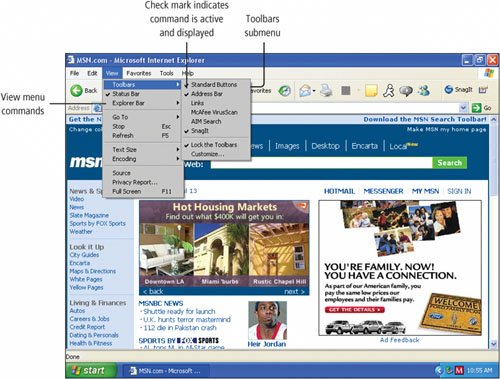
Check marks indicate commands that are currently active and displayed. If you click a checked command, the check mark is removed and the command is deactivated. |
|
|
|
|
3. |
Click Address Bar to hide the Address bar. Click it again to display it. |
|
4. |
From the View menu, click Toolbars, and then click Standard Buttons to hide the Standard Buttons toolbar. Click it again to display it. |
|
5. |
On the menu bar, click Tools to display the Tools menu and notice the list of commands on this menu. These commands are used to manage the manner in which Internet Explorer works for you. |
Activity 1.3. Performing Commands Using the Standard Buttons Toolbar
|
1. |
On the Standard Buttons toolbar, click the Back button |
|
|
|
|
2. |
On the Standard Buttons toolbar, point to, but do not click, the Forward button Figure 1.6. 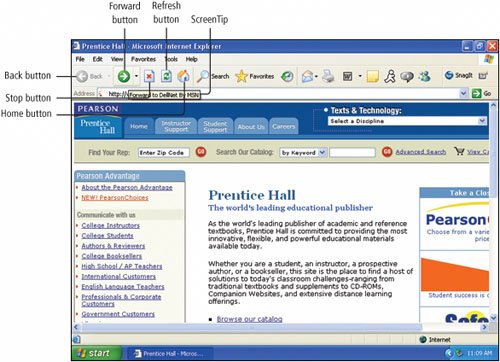
A ScreenTip identifies the Web page that will display when you click the button. |
|
3. |
On the Standard Buttons toolbar, click the Forward button |
|
4. |
On the Standard Buttons toolbar, click the Home button |
Activity 1.4. Accessing Web Sites from the Address Bar
|
1. |
Near the top of the Internet Explorer window, click anywhere in the Address Bar box. |
||||||||
|
2. |
With the current Web address selected, type www.firstgov.gov Press Figure 1.7. 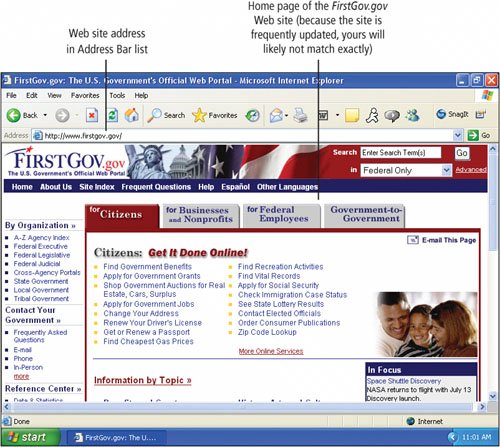
The FirstGov.gov site's home page displays. When an existing Web address is selected, typing a new address replaces the selected text. As you type, a list might display. Internet Explorer remembers the last 25 Web addresses you entered and displays a list containing site addresses that start with the characters you type. When you type the www, Internet Explorer displays a list of all the sites you have accessed recently that begin with www. The list gets shorter with each character you type. If you see the site you are typing in the Address Bar list, you can click the site name in the list rather than typing the complete address. |
||||||||
|
3. |
Take a moment to study the table in Figure 1.8 that describes how Web addresses are formed.
|
||||||||
|
4. |
Click the Address Bar box again, type www.bls.gov and press Figure 1.9. (This item is displayed on page 137 in the print version) 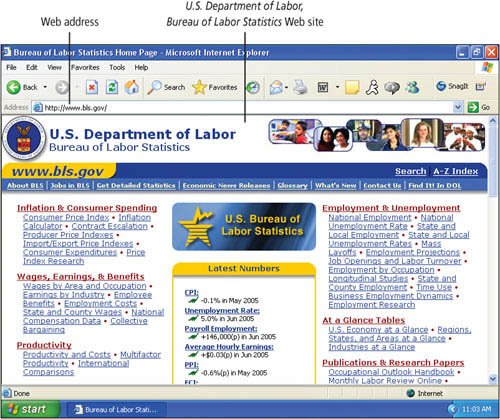
The U.S. Department of Labor, Bureau of Labor Statistics Web site displays. Recall that because sites are regularly updated, your screen will likely not match Figure 1.9 exactly. The .gov in the Web address is called a top-level domain and identifies the site as a government site. |
||||||||
|
|
|||||||||
|
5. |
At the right end of the Address Bar box, click the Address Bar box down arrow and point to, but do not click, the http://www.firstgov.gov Web address. Compare your screen to Figure 1.10. Figure 1.10. (This item is displayed on page 138 in the print version) 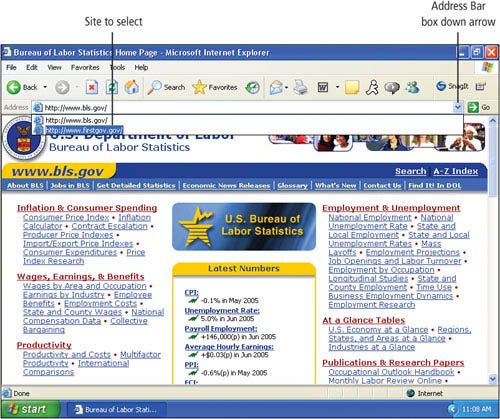
The list of recently accessed Web sites on your computer will differ from those shown in Figure 1.10. The sites listed represent those most frequently visited on your computer. |
||||||||
|
|
|||||||||
|
6. |
In the displayed list, click the http://www.firstgov.gov Web address. Then, in the Address Bar box, type www.ed.gov and press |
||||||||
|
7. |
On the Standard Buttons toolbar, locate the Back button down arrow Figure 1.11. 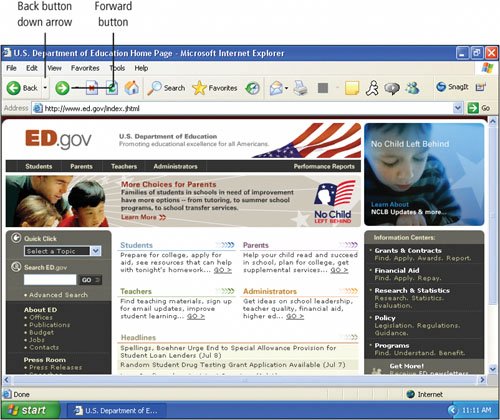
|
||||||||
|
8. |
From the Standard Buttons toolbar, click the Favorites button to display the task pane. Click MSN.com, and watch this site's home page for a few moments and notice that text and images change. Figure 1.12. 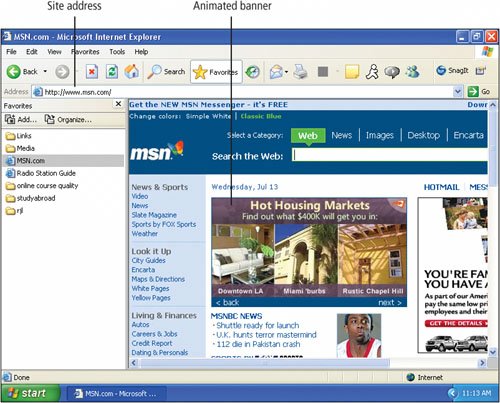
|
||||||||
|
9. |
In the Favorites task pane, click the Close button Figure 1.13. (This item is displayed on page 141 in the print version) 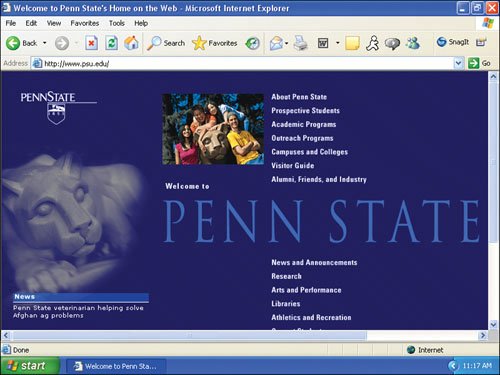
Internet Explorer displays the Penn State Web site. The .edu extension is reserved for schools, colleges, and universities. |
||||||||
|
|
|||||||||
|
10. |
On the Standard Buttons toolbar, click the Home button |
Activity 1.5. Displaying Web Pages with Hyperlinks
Most Web sites contain hyperlinks, which provide another navigation tool for browsing Web pages. Hyperlinks are text, buttons, pictures, or other objects displayed on Web pages that, when clicked, access other Web pages or display other sections of the active page. Linked Web pages can be pages within the same Web site or Web pages on sites of other companies, schools, or organizations. In this activity, you will use hyperlinks to display Web pages about college financial aid.
|
1. |
In the Address Bar box, type www.students.gov and press Figure 1.14. (This item is displayed on page 142 in the print version) 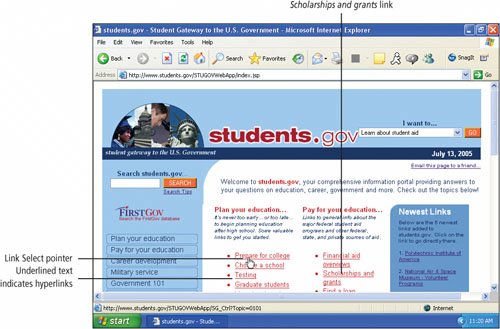
Internet Explorer displays the students.gov home page. As you review Figure 1.14, notice that the mouse pointer displays as a pointing handthe Link Select pointerwhen you point to an item that links to another Web page. Many Web pages contain links that connect to other pages on the site. These other pages contain links that lead back to the home page that displays each time you access the other pages. |
|
|
|
|
2. |
Locate and then click the link for Scholarships and grants. Compare your screen to Figure 1.15. Figure 1.15. (This item is displayed on page 143 in the print version) 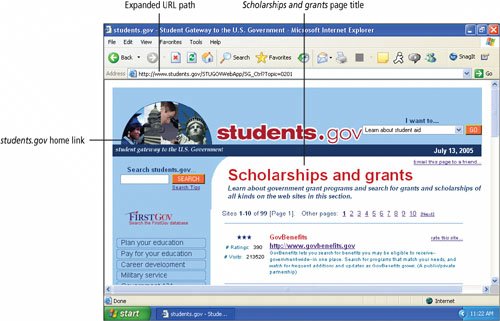
The Scholarships and grants screen displays. The address in the Address bar still shows the students.gov Web site, but the URL has expanded to identify the path for this page. Alert!: Web Site Doesn't Appear? Because Web sites are updated frequently, the links on the Web sites also change. If the Scholarships and grants link on the students.gov Web site does not display, select another link to follow. |
|
3. |
On the Standard Buttons toolbar, click the Back button |
|
4. |
Scroll down as necessary to locate the link for State financial aid and click it. Compare your screen with Figure 1.16. If you want to do so, scroll down and try to find information about your state. At the bottom of the screen, click the numbers to move forward in the list of states. Each link to state financial aid information will open in a new window. When you are finished, return to the State financial aid Web page by clicking the Close button in the upper right corner of the new window. This will close the window that displayed the State financial aid page and return you to the students.gov Web page. Figure 1.16. (This item is displayed on page 144 in the print version) 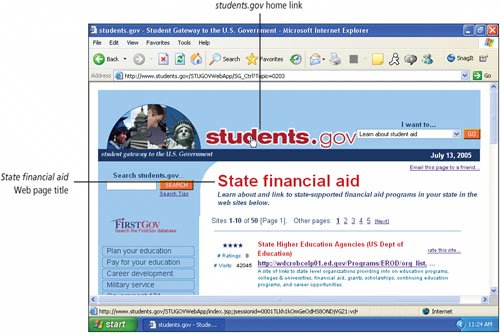
Internet Explorer opens each of the links shown on the State financial aid Web page in a new window. Each Web page contains settings that control whether linked pages open in a separate window or in the same window. In addition, settings that are active on your computer control the linked page's display. The new Web page opens in a separate window because the window displays as a pop-up on top of the State financial aid window. Notice that another button displays on the Windows taskbar at the bottom of your screen that shows the name of the new Web page. Both the Back and Forward buttons of the new window are unavailable. So far, all the links you have used connect to other pages within the students.gov Web site. Other sites contain links that connect you to other Web sites. |
|
5. |
Click in the Address Bar box, type www.usgovernment.com and press Figure 1.17. 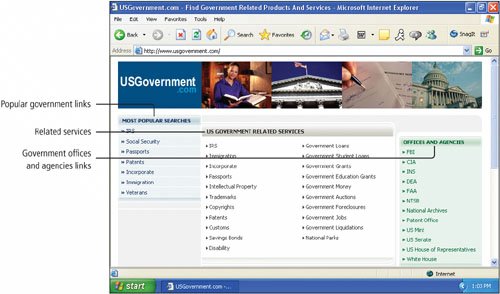
|
|
6. |
Locate and then click the link for Government Education Grants. Click one of the Sponsored Results links. Compare your screen with Figure 1.18. The new window that opens may differ from the one shown here. On the Web page that provided Search Results links, click the link to www.freescholarshipguide.com. Notice that the top-level domain name (.com) in the Address bar is a commercial Web site. It has paid to be listed prominently in the search returns. Figure 1.18. (This item is displayed on page 146 in the print version) 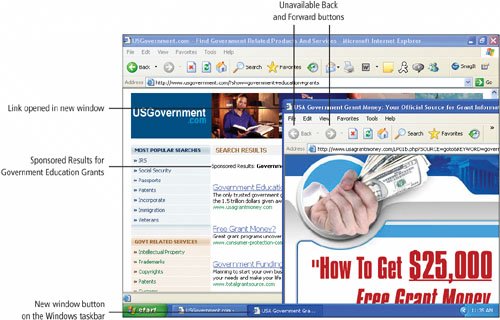
Internet Explorer opens each of the links shown on the Government Education Grants Web page in a new window. You can tell the new Web page opens in a separate window because the window displays as a pop-up on top of the Government Education Grants window and another button displays on the Windows taskbar at the bottom of your screen that shows the name of the new Web page. Both the Back and Forward buttons of the new window are unavailable. When you have finished viewing this new Web page, click the Close button in the upper right corner of the new window. |
|
|
|
|
7. |
On the displayed Web site's title bar, click the Close button |
Activity 1.6. Using Internet Explorer History
The Internet Explorer History feature tracks recently visited Web pages and sites. You can display the History list and select a site that you recently visited. By default, Internet Explorer tracks sites visited in the last 20 days. To reduce the amount of disk storage space required to maintain the History list, you can customize the settings to change the number of days tracked and to clear the list. In this activity, you will use the History list to display recently visited sites.
|
1. |
On the Standard Buttons toolbar, click the History button Figure 1.19. (This item is displayed on page 147 in the print version) 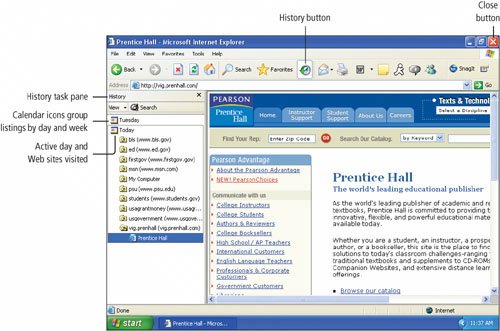
The History task pane displays on the left side of the Internet Explorer window. The listings of items on your computer will differ from those shown in the figure. However, many of the listings shown for Today should be the same. Notice that the links to sites accessed today display in alphabetical order. |
|
|
|
|
2. |
In the History task pane, click the bls (www.bls.gov) link, and then compare your screen to Figure 1.20. Figure 1.20. (This item is displayed on page 148 in the print version) 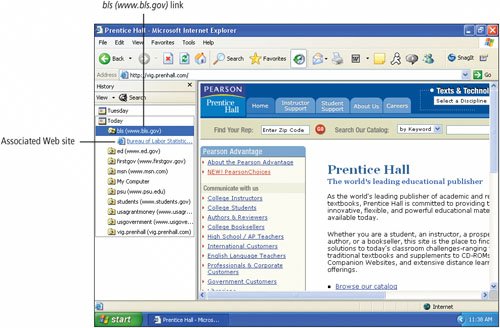
The Web site name associated with the folder displays as a link below the folder. |
|
|
|
|
3. |
Scroll down the History task pane as necessary, and then click the firstgov link to display the associated Web site name for the Firstgov.gov Web site. |
|
4. |
On the Standard Buttons toolbar, click the History button |
More Knowledge: Setting History Options
The default setting for the History pane displays Web pages visited in the last 20 days. You can change the options that control the History pane and also clear the History list by setting Internet Options. On the Internet Explorer menu bar, click Tools, and then click Internet Options to open the Internet Options dialog box. In the dialog box, click the Clear History button to remove all site listings; then click Yes to confirm the deletion. You can also click the spin arrows beside Days to keep pages in history to increase or decrease the number of days tracked on the History task pane.
Objective 3 Create and Manage Favorites |
Windows XP
- Chapter One. Getting Started with Windows XP
- Project 1A. Windows XP
- Objective 1. Get Started with Windows XP
- Objective 2. Resize, Move, and Scroll Windows
- Objective 3. Maximize, Restore, Minimize, and Close a Window
- Objective 4. Create a New Folder
- Objective 5. Copy, Move, Rename, and Delete Files
- Objective 6. Find Files and Folders
- Objective 7. Compress Files
- Summary
- Key Terms
- Concepts Assessments
Outlook 2003
- Chapter One. Getting Started with Outlook 2003
- Getting Started with Microsoft Office Outlook 2003
- Project 1A. Exploring Outlook 2003
- Objective 1. Start and Navigate Outlook
- Objective 2. Read and Respond to E-mail
- Objective 3. Store Contact and Task Information
- Objective 4. Work with the Calendar
- Objective 5. Delete Outlook Information and Close Outlook
- Summary
- Key Terms
- Concepts Assessments
- Skill Assessments
- Performance Assessments
- Mastery Assessments
- Problem Solving
- GO! with Help
Internet Explorer
- Chapter One. Getting Started with Internet Explorer
- Getting Started with Internet Explorer 6.0
- Project 1A. College and Career Information
- Objective 1. Start Internet Explorer and Identify Screen Elements
- Objective 2. Navigate the Internet
- Objective 3. Create and Manage Favorites
- Objective 4. Search the Internet
- Objective 5. Save and Print Web Pages
- Summary
- Key Terms
- Concepts Assessments
- Skill Assessments
- Performance Assessments
- Mastery Assessments
- Problem Solving
Computer Concepts
- Chapter One. Basic Computer Concepts
- Objective 1. Define Computer and Identify the Four Basic Computing Functions
- Objective 2. Identify the Different Types of Computers
- Objective 3. Describe Hardware Devices and Their Uses
- Objective 4. Identify Types of Software and Their Uses
- Objective 5. Describe Networks and Define Network Terms
- Objective 6. Identify Safe Computing Practices
- Summary
- In this Chapter You Learned How to
- Key Terms
- Concepts Assessments
Word 2003
Chapter One. Creating Documents with Microsoft Word 2003
- Chapter One. Creating Documents with Microsoft Word 2003
- Getting Started with Microsoft Office Word 2003
- Project 1A. Thank You Letter
- Objective 1. Create and Save a New Document
- Objective 2. Edit Text
- Objective 3. Select, Delete, and Format Text
- Objective 4. Create Footers and Print Documents
- Project 1B. Party Themes
- Objective 5. Navigate the Word Window
- Objective 6. Add a Graphic to a Document
- Objective 7. Use the Spelling and Grammar Checker
- Objective 8. Preview and Print Documents, Close a Document, and Close Word
- Objective 9. Use the Microsoft Help System
- Summary
- Key Terms
- Concepts Assessments
- Skill Assessments
- Performance Assessments
- Mastery Assessments
- Problem Solving
- You and GO!
- Business Running Case
- GO! with Help
Chapter Two. Formatting and Organizing Text
- Formatting and Organizing Text
- Project 2A. Alaska Trip
- Objective 1. Change Document and Paragraph Layout
- Objective 2. Change and Reorganize Text
- Objective 3. Create and Modify Lists
- Project 2B. Research Paper
- Objective 4. Insert and Format Headers and Footers
- Objective 5. Insert Frequently Used Text
- Objective 6. Insert and Format References
- Summary
- Key Terms
- Concepts Assessments
- Skill Assessments
- Performance Assessments
- Mastery Assessments
- Problem Solving
- You and GO!
- Business Running Case
- GO! with Help
Chapter Three. Using Graphics and Tables
- Using Graphics and Tables
- Project 3A. Job Opportunities
- Objective 1. Insert and Modify Clip Art and Pictures
- Objective 2. Use the Drawing Toolbar
- Project 3B. Park Changes
- Objective 3. Set Tab Stops
- Objective 4. Create a Table
- Objective 5. Format a Table
- Objective 6. Create a Table from Existing Text
- Summary
- Key Terms
- Concepts Assessments
- Skill Assessments
- Performance Assessments
- Mastery Assessments
- Problem Solving
- You and GO!
- Business Running Case
- GO! with Help
Chapter Four. Using Special Document Formats, Columns, and Mail Merge
- Using Special Document Formats, Columns, and Mail Merge
- Project 4A. Garden Newsletter
- Objective 1. Create a Decorative Title
- Objective 2. Create Multicolumn Documents
- Objective 3. Add Special Paragraph Formatting
- Objective 4. Use Special Character Formats
- Project 4B. Water Matters
- Objective 5. Insert Hyperlinks
- Objective 6. Preview and Save a Document as a Web Page
- Project 4C. Recreation Ideas
- Objective 7. Locate Supporting Information
- Objective 8. Find Objects with the Select Browse Object Button
- Project 4D. Mailing Labels
- Objective 9. Create Labels Using the Mail Merge Wizard
- Summary
- Key Terms
- Concepts Assessments
- Skill Assessments
- Performance Assessments
- Mastery Assessments
- Problem Solving
- You and GO!
- Business Running Case
- GO! with Help
Excel 2003
Chapter One. Creating a Worksheet and Charting Data
- Creating a Worksheet and Charting Data
- Project 1A. Tableware
- Objective 1. Start Excel and Navigate a Workbook
- Objective 2. Select Parts of a Worksheet
- Objective 3. Enter and Edit Data in a Worksheet
- Objective 4. Construct a Formula and Use the Sum Function
- Objective 5. Format Data and Cells
- Objective 6. Chart Data
- Objective 7. Annotate a Chart
- Objective 8. Prepare a Worksheet for Printing
- Objective 9. Use the Excel Help System
- Project 1B. Gas Usage
- Objective 10. Open and Save an Existing Workbook
- Objective 11. Navigate and Rename Worksheets
- Objective 12. Enter Dates and Clear Formats
- Objective 13. Use a Summary Sheet
- Objective 14. Format Worksheets in a Workbook
- Summary
- Key Terms
- Concepts Assessments
- Skill Assessments
- Performance Assessments
- Mastery Assessments
- Problem Solving
- You and GO!
- Business Running Case
- GO! with Help
Chapter Two. Designing Effective Worksheets
- Designing Effective Worksheets
- Project 2A. Staff Schedule
- Objective 1. Use AutoFill to Fill a Pattern of Column and Row Titles
- Objective 2. Copy Text Using the Fill Handle
- Objective 3. Use AutoFormat
- Objective 4. View, Scroll, and Print Large Worksheets
- Project 2B. Inventory Value
- Objective 5. Design a Worksheet
- Objective 6. Copy Formulas
- Objective 7. Format Percents, Move Formulas, and Wrap Text
- Objective 8. Make Comparisons Using a Pie Chart
- Objective 9. Print a Chart on a Separate Worksheet
- Project 2C. Population Growth
- Objective 10. Design a Worksheet for What-If Analysis
- Objective 11. Perform What-If Analysis
- Objective 12. Compare Data with a Line Chart
- Summary
- Key Terms
- Concepts Assessments
- Skill Assessments
- Performance Assessments
- Mastery Assessments
- Problem Solving
- You and GO!
- Business Running Case
- GO! with Help
Chapter Three. Using Functions and Data Tables
- Using Functions and Data Tables
- Project 3A. Geography Lecture
- Objective 1. Use SUM, AVERAGE, MIN, and MAX Functions
- Objective 2. Use a Chart to Make Comparisons
- Project 3B. Lab Supervisors
- Objective 3. Use COUNTIF and IF Functions, and Apply Conditional Formatting
- Objective 4. Use a Date Function
- Project 3C. Loan Payment
- Objective 5. Use Financial Functions
- Objective 6. Use Goal Seek
- Objective 7. Create a Data Table
- Summary
- Key Terms
- Concepts Assessments
- Skill Assessments
- Performance Assessments
- Mastery Assessments
- Problem Solving
- You and GO!
- Business Running Case
- GO! with Help
Access 2003
Chapter One. Getting Started with Access Databases and Tables
- Getting Started with Access Databases and Tables
- Project 1A. Academic Departments
- Objective 1. Rename a Database
- Objective 2. Start Access, Open an Existing Database, and View Database Objects
- Project 1B. Fundraising
- Objective 3. Create a New Database
- Objective 4. Create a New Table
- Objective 5. Add Records to a Table
- Objective 6. Modify the Table Design
- Objective 7. Create Table Relationships
- Objective 8. Find and Edit Records in a Table
- Objective 9. Print a Table
- Objective 10. Close and Save a Database
- Objective 11. Use the Access Help System
- Summary
- Key Terms
- Concepts Assessments
- Skill Assessments
- Performance Assessments
- Mastery Assessments
- Problem Solving Assessments
- Problem Solving
- You and GO!
- Business Running Case
- GO! with Help
Chapter Two. Sort, Filter, and Query a Database
- Sort, Filter, and Query a Database
- Project 2A. Club Fundraiser
- Objective 1. Sort Records
- Objective 2. Filter Records
- Objective 3. Create a Select Query
- Objective 4. Open and Edit an Existing Query
- Objective 5. Sort Data in a Query
- Objective 6. Specify Text Criteria in a Query
- Objective 7. Print a Query
- Objective 8. Specify Numeric Criteria in a Query
- Objective 9. Use Compound Criteria
- Objective 10. Create a Query Based on More Than One Table
- Objective 11. Use Wildcards in a Query
- Objective 12. Use Calculated Fields in a Query
- Objective 13. Group Data and Calculate Statistics in a Query
- Summary
- Key Terms
- Concepts Assessments
- Skill Assessments
- Performance Assessments
- Mastery Assessments
- Problem Solving
- You and GO!
- Business Running Case
- GO! with Access Help
Chapter Three. Forms and Reports
- Forms and Reports
- Project 3A. Fundraiser
- Objective 1. Create an AutoForm
- Objective 2. Use a Form to Add and Delete Records
- Objective 3. Create a Form Using the Form Wizard
- Objective 4. Modify a Form
- Objective 5. Create an AutoReport
- Objective 6. Create a Report Using the Report Wizard
- Objective 7. Modify the Design of a Report
- Objective 8. Print a Report and Keep Data Together
- Summary
- Key Terms
- Concepts Assessments
- Skill Assessments
- Performance Assessments
- Mastery Assessments
- Problem Solving
- You and GO!
- Business Running Case
- GO! with Help
Powerpoint 2003
Chapter One. Getting Started with PowerPoint 2003
- Getting Started with PowerPoint 2003
- Project 1A. Expansion
- Objective 1. Start and Exit PowerPoint
- Objective 2. Edit a Presentation Using the Outline/Slides Pane
- Objective 3. Format and Edit a Presentation Using the Slide Pane
- Objective 4. View and Edit a Presentation in Slide Sorter View
- Objective 5. View a Slide Show
- Objective 6. Create Headers and Footers
- Objective 7. Print a Presentation
- Objective 8. Use PowerPoint Help
- Summary
- Key Terms
- Concepts Assessments
- Skill Assessments
- Performance Assessments
- Mastery Assessments
- Problem Solving
- You and GO!
- Business Running Case
- GO! with Help
Chapter Two. Creating a Presentation
- Creating a Presentation
- Project 2A. Teenagers
- Objective 1. Create a Presentation
- Objective 2. Modify Slides
- Project 2B. History
- Objective 3. Create a Presentation Using a Design Template
- Objective 4. Import Text from Word
- Objective 5. Move and Copy Text
- Summary
- Key Terms
- Concepts Assessments
- Skill Assessments
- Performance Assessments
- Mastery Assessments
- Problem Solving
- You and GO!
- Business Running Case
- GO! with Help
Chapter Three. Formatting a Presentation
- Project 3A. Emergency
- Objective 1. Format Slide Text
- Objective 2. Modify Placeholders
- Objective 3. Modify Slide Master Elements
- Objective 4. Insert Clip Art
- Project 3B. Volunteers
- Objective 5. Apply Bullets and Numbering
- Objective 6. Customize a Color Scheme
- Objective 7. Modify the Slide Background
- Objective 8. Apply an Animation Scheme
- Summary
- Key Terms
- Concepts Assessments
- Skill Assessments
- Performance Assessments
- Mastery Assessments
- Problem Solving
- You and GO!
- Business Running Case
- GO! with Help
Integrated Projects
Chapter One. Using Access Data with Other Office Applications
- Chapter One. Using Access Data with Other Office Applications
- Introduction
- Project 1A. Meeting Slides
- Objective 1. Export Access Data to Excel
- Objective 2. Create a Formula in Excel
- Objective 3. Create a Chart in Excel
- Objective 4. Copy Access Data into a Word Document
- Objective 5. Copy Excel Data into a Word Document
- Objective 6. Insert an Excel Chart into a PowerPoint Presentation
Chapter Two. Using Tables in Word and Excel
- Chapter Two. Using Tables in Word and Excel
- Introduction
- Project 2A. Meeting Notes
- Objective 1. Plan a Table in Word
- Objective 2. Enter Data and Format a Table in Word
- Objective 3. Create a Table in Word from Excel Data
- Objective 4. Create Excel Worksheet Data from a Word Table
Chapter Three. Using Excel as a Data Source in a Mail Merge
- Chapter Three. Using Excel as a Data Source in a Mail Merge
- Introduction
- Project 3A. Mailing Labels
- Objective 1. Prepare a Mail Merge Document as Mailing Labels
- Objective 2. Choose an Excel Worksheet as a Data Source
- Objective 3. Produce and Save Merged Mailing Labels
- Objective 4. Open a Saved Main Document for Mail Merge
Chapter Four. Linking Data in Office Documents
- Chapter Four. Linking Data in Office Documents
- Introduction
- Project 4A. Weekly Sales
- Objective 1. Insert and Link in Word an Excel Object
- Objective 2. Format an Object in Word
- Objective 3. Open a Word Document That Includes a Linked Object, and Update Links
Chapter Five. Creating Presentation Content from Office Documents
EAN: 2147483647
Pages: 448
 to return to your home page, and then notice that the Forward button
to return to your home page, and then notice that the Forward button  becomes available.
becomes available. .
. , and then compare your screen with Figure 1.7.
, and then compare your screen with Figure 1.7. . In the Address Bar box, type www.psu.edu and press
. In the Address Bar box, type www.psu.edu and press  displays, as shown in Figure 1.14.
displays, as shown in Figure 1.14. to close the new window. Then, on the Standard Buttons toolbar, click the Home button
to close the new window. Then, on the Standard Buttons toolbar, click the Home button  , and then compare your screen with Figure 1.19.
, and then compare your screen with Figure 1.19.